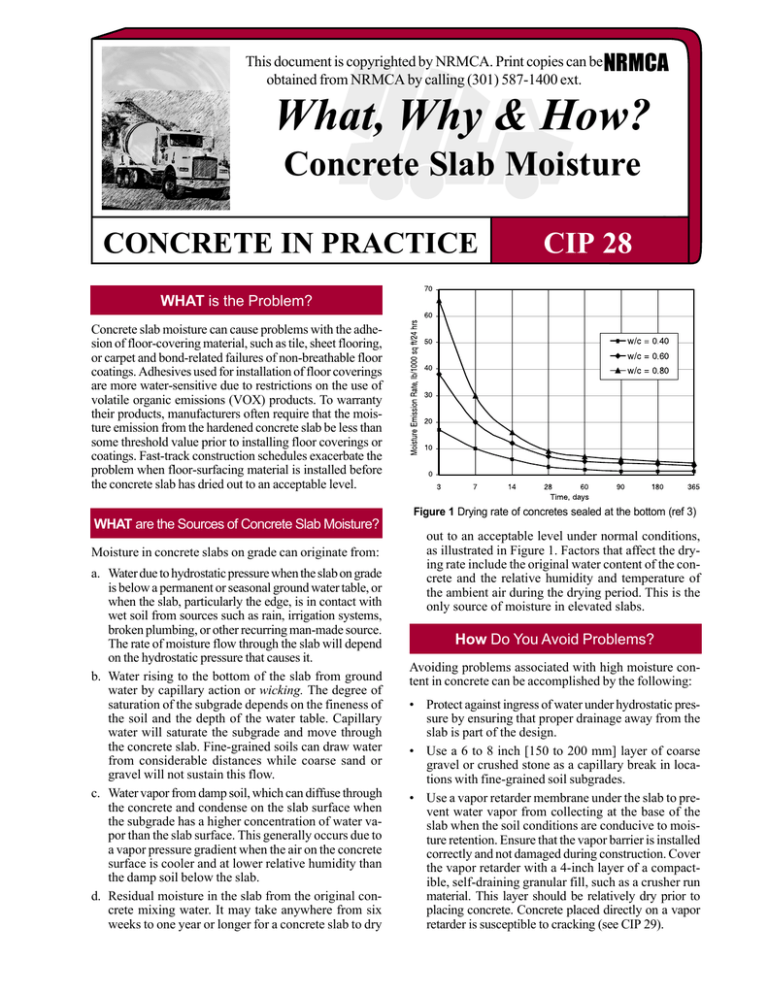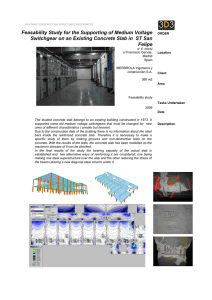
This document is copyrighted by NRMCA. Print copies can be NRMCA
obtained from NRMCA by calling (301) 587-1400 ext.
What, Why & How?
Concrete Slab Moisture
CONCRETE IN PRACTICE
CIP 28
WHAT is the Problem?
Concrete slab moisture can cause problems with the adhesion of floor-covering material, such as tile, sheet flooring,
or carpet and bond-related failures of non-breathable floor
coatings. Adhesives used for installation of floor coverings
are more water-sensitive due to restrictions on the use of
volatile organic emissions (VOX) products. To warranty
their products, manufacturers often require that the moisture emission from the hardened concrete slab be less than
some threshold value prior to installing floor coverings or
coatings. Fast-track construction schedules exacerbate the
problem when floor-surfacing material is installed before
the concrete slab has dried out to an acceptable level.
Figure 1 Drying rate of concretes sealed at the bottom (ref 3)
WHAT are the Sources of Concrete Slab Moisture?
Moisture in concrete slabs on grade can originate from:
a. Water due to hydrostatic pressure when the slab on grade
is below a permanent or seasonal ground water table, or
when the slab, particularly the edge, is in contact with
wet soil from sources such as rain, irrigation systems,
broken plumbing, or other recurring man-made source.
The rate of moisture flow through the slab will depend
on the hydrostatic pressure that causes it.
b. Water rising to the bottom of the slab from ground
water by capillary action or wicking. The degree of
saturation of the subgrade depends on the fineness of
the soil and the depth of the water table. Capillary
water will saturate the subgrade and move through
the concrete slab. Fine-grained soils can draw water
from considerable distances while coarse sand or
gravel will not sustain this flow.
c. Water vapor from damp soil, which can diffuse through
the concrete and condense on the slab surface when
the subgrade has a higher concentration of water vapor than the slab surface. This generally occurs due to
a vapor pressure gradient when the air on the concrete
surface is cooler and at lower relative humidity than
the damp soil below the slab.
d. Residual moisture in the slab from the original concrete mixing water. It may take anywhere from six
weeks to one year or longer for a concrete slab to dry
out to an acceptable level under normal conditions,
as illustrated in Figure 1. Factors that affect the drying rate include the original water content of the concrete and the relative humidity and temperature of
the ambient air during the drying period. This is the
only source of moisture in elevated slabs.
How Do You Avoid Problems?
Avoiding problems associated with high moisture content in concrete can be accomplished by the following:
• Protect against ingress of water under hydrostatic pressure by ensuring that proper drainage away from the
slab is part of the design.
• Use a 6 to 8 inch [150 to 200 mm] layer of coarse
gravel or crushed stone as a capillary break in locations with fine-grained soil subgrades.
• Use a vapor retarder membrane under the slab to prevent water vapor from collecting at the base of the
slab when the soil conditions are conducive to moisture retention. Ensure that the vapor barrier is installed
correctly and not damaged during construction. Cover
the vapor retarder with a 4-inch layer of a compactible, self-draining granular fill, such as a crusher run
material. This layer should be relatively dry prior to
placing concrete. Concrete placed directly on a vapor
retarder is susceptible to cracking (see CIP 29).
• Use a good quality concrete mixture with a low water
content. A low water content will reduce the amount of
residual moisture in the slab, require a shorter drying
period, and have a low permeability to moisture. The
water tightness of concrete can be improved by using fly
ash or slag in the concrete mixture. Place concrete at a
moderate slump not exceeding 5 inches [125 mm]. Water reducing admixtures can be used to obtain adequate
workability and maintain a low water content.
• Cure the concrete by ponding water, covering it with
wet burlap, or spraying curing compounds, for a minimum 3 to 7 days. Curing is an important step in achieving a high quality slab with reduced moisture transmission. Avoid using wax-based curing compounds on
floors where coverings or coatings will be installed.
• Allow sufficient time for the moisture in the slab to
dry out naturally while the floor is under a roof and
protected from the elements. Use heat and dehumidifiers to accelerate drying. Since moisture transmission
is affected by temperature and humidity, maintain the
actual service conditions for a long enough period prior
to installing the floor covering.
• Test the slab moisture condition prior to installing the
floor covering.
When concrete slab moisture cannot be controlled, consider using less moisture-sensitive floor coverings or
breathable floor coatings.
How is Concrete Slab Moisture Measured?
Various qualitative and quantitative methods of measuring concrete slab moisture are described in ASTM E 1907.
Test the moisture condition of the slab in the same temperature and humidity conditions as it will be in service.
In general, test in three random sample locations for areas up to 1000 sq. ft. [100 m2]. Ensure that the surface is
dry and clean. Record the relative humidity and temperature at the time of testing. Some of the common tests are:
Polyethylene Sheet Test - is a simple qualitative test
that is commonly used, where an 18 by 18 inch [450 by
450 mm] square plastic sheet is taped tightly to the
concrete and left in place for a minimum 16 hours. The
plastic sheet and the slab are then visually inspected for
the presence of moisture.
Mat Test - where the adhesive intended for use is applied
to a 24 by 24 inch [600 by 600 mm] area and a sheet
vinyl flooring product is placed face down on the adhesive and sealed at the edges. A visual inspection of the
condition of the adhesive is made after a 72-hour period.
Moisture meters - based on electrical resistance or impedance measurements are used to measure slab moisture. The
resistance meters are subject to errors and are seldom used.
Gravimetric - This is a direct and accurate method of
determining moisture content in the concrete surface.
Pieces of the concrete surface are removed and dried in an
oven to constant weight. The moisture content is then calculated as a percentage of the dry sample weight. Generally,
moisture content less than 3 to 4% is considered suitable for
application of non-breathable floor coatings.
Nuclear Density and Radio Frequency - These tests
have a high degree of reliability, are nondestructive, but
are expensive and take a longer period of time to properly
correlate correction factors for each individual project.
Anhydrous Calcium Chloride Test - is a popular test chosen
by several flooring manufacturers who specify criteria for
flooring or carpet installation based on this method. A measured amount of anhydrous calcium chloride is placed in a
sealed area on the surface and the amount of moisture absorbed by the salt in 60 to 72 hours is measured to calculate
the moisture vapor emission rate (MVER). Maximum limits of vapor transmission generally specified are 3 to 5 pounds
of moisture per 1000 square feet per 24 hours. This test is
relatively inexpensive, yields a quantitative result, but is
subject to errors when testing as the salt has a strong affinity
for water.
Hygrometer – A test area of the floor is sealed off under a
waterproof enclosure. The relative humidity of the pocket of
air trapped above the slab is measured using a hygrometer
or a relative humidity probe after at least 72 hours. Flooring
can be installed if the relative humidity is less than 75%.
Test Strip – in which a test strip of the proposed primer
or adhesive is evaluated for 24 hours to predict its behavior on the floor. This procedure is not very reliable.
References
1. Guide to Concrete Floor and Slab Construction, ACI 302.1R,
American Concrete Institute, Farmington Hills, MI.
2. ASTM E 1907, Standard Practice for Determining MoistureRelated Acceptability of Concrete Floors to Receive Moisture-Sensitive Finishes, ASTM, West Conshohocken, PA.
3. Bruce Suprenant, Moisture Movement Through Concrete
Slabs, Concrete Construction, November 1997.
4. Thomas K. Butt, Avoiding and Repairing Moisture Problems
in Slabs on Grade, The Construction Specifier, December, 1992.
5. Malcolm Rode and Doug Wendler, Methods for Measuring
Moisture Content in Concrete, Concrete Repair Bulletin,
March-April, 1996.
6. Steven H. Kosmatka, Floor-Covering Materials and Moisture in Concrete. Portland Cement Association, Skokie, IL.
Follow These Rules to Avoid Problems with Slab Moisture
1. Evaluate the site to determine the potential for moisture migration and incorporate mitigative measures in the
design phase.
2. Use a good quality concrete with a low water content and a low permeability to moisture.
3. Follow good concrete practices for placing, finishing, and curing.
4. Allow the slab to dry out and test the moisture emission rate prior to installing floor coverings or coatings.
Technical information prepared by
National Ready Mixed Concrete Association
900 Spring Street
Silver Spring, Maryland 20910
Printed in U.S.A.
© National Ready Mixed Concrete Association.
All rights reserved.
No part of this publication may be reproduced in any form, including
photocopying or other electronic means, without permission in writing
from the National Ready Mixed Concrete Association.
Copyright NATIONAL READY MIXED CONCRETE ASSOCIATION, 1998
CIP 100/28/0060/10.0/DMSC

